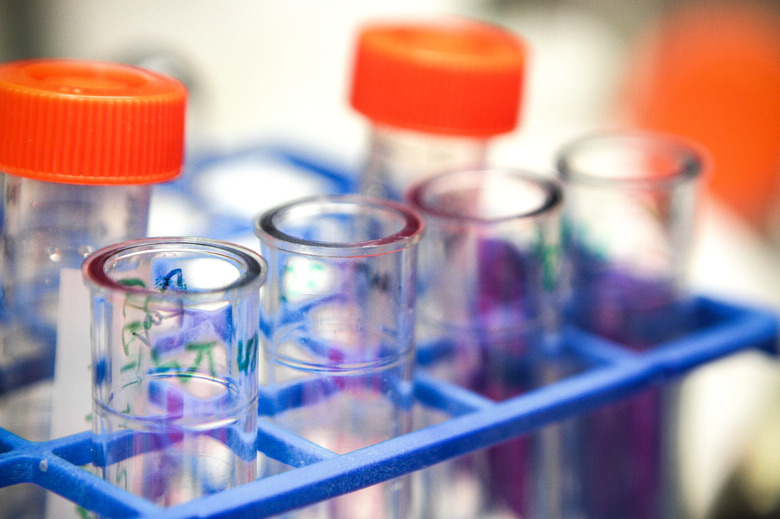How To Figure Out An mRNA Sequence
When you think about your genetic material, you probably picture the genes responsible for your eye color or your height. While your DNA certainly determines aspects of your appearance, it also codes for all the molecules that allow your body systems to function. Synthesizing those molecules requires an intermediary to carry the DNA blueprint out of the nucleus and into the rest of the cell. That important job belongs to messenger RNA.
TL;DR (Too Long; Didn't Read)
Double-stranded DNA contains bases (A, T, G and C) that always bond in the same pairs (A-T and G-C). During transcription, RNA polymerase travels along the DNA template strand, encoding a short, single-stranded messenger RNA that matches the DNA coding strand with a fifth base (U) substituted for every T. A DNA coding strand sequence AGCAATC pairs with DNA template strand sequence TCGTTAG. The mRNA sequence AGCAAUC matches the coding strand sequence with the U/T change.
What Is transcription?
What Is transcription?
The process of transcription allows an enzyme called RNA polymerase to bind to your DNA and unzip the hydrogen bonds that hold the two strands together. This forms a bubble of open DNA approximately ten bases long. As the enzyme moves down this small sequence of DNA, it reads the code and produces a short strand of messenger RNA (mRNA) that matches the coding strand of your DNA. The mRNA then travels out of the nucleus, bringing that bit of your genetic code to the cytoplasm where the code can be used to build molecules like proteins.
Understanding Base Pairs
Understanding Base Pairs
The actual coding of the mRNA transcript is very straightforward. DNA contains four bases: adenine (A), thymine (T), guanine (G) and cytosine (C). Since DNA is double-stranded, the strands hold together where the bases pair. A always pairs with T, and G always pairs with C.
Scientists call the two strands of your DNA the coding strand and the template strand. RNA polymerase builds the mRNA transcript using the template strand. To visualize, imagine your coding strand reads AGCAATC. Since the template strand must contain base pairs that bond precisely with the coding strand, the template reads TCGTTAG.
Building mRNA Transcripts
Building mRNA Transcripts
However, mRNA contains an essential difference in its sequence: In place of every thymine (T), mRNA contains a uracil (U) substitution. Thymine and uracil are almost identical. Scientists believe that the A-T bond is responsible for the formation of the double helix; since mRNA is just one small strand and does not need to twist, this substitution makes the transfer of information easier for your cell's machinery.
Looking at the earlier sequence, an mRNA transcript constructed using the template strand would read AGCAAUC since it contains the bases that pair with the template strand of the DNA (with the uracil substitution). If you compare the coding strand (AGCAATC) with this transcript (AGCAAUC), you can see that they are exactly the same except for the thymine/uracil change. When the mRNA travels into the cytoplasm to deliver this blueprint, the code it carries matches the original coding sequence.
Why Transcription Matters
Why Transcription Matters
Sometimes students receive assignments asking them to write out the sequence changes from coding strand to template strand to mRNA, probably as a way to help the student learn the process of transcription. In real life, understanding these sequences is crucial because even extremely small changes (like a single base substitution) can alter the synthesized protein. Sometimes scientists even trace human diseases back to these tiny changes or mutations. This allows scientists to study human disease and investigate how processes like transcription and protein synthesis work.
Your DNA is responsible for obvious features like eye color or height but also for the molecules your body builds and uses. Learning the sequence changes from coding DNA to template DNA to mRNA is the first step to understanding how these processes work.
Cite This Article
MLA
Mayer, Melissa. "How To Figure Out An mRNA Sequence" sciencing.com, https://www.sciencing.com/figure-out-mrna-sequence-8709669/. 9 May 2018.
APA
Mayer, Melissa. (2018, May 9). How To Figure Out An mRNA Sequence. sciencing.com. Retrieved from https://www.sciencing.com/figure-out-mrna-sequence-8709669/
Chicago
Mayer, Melissa. How To Figure Out An mRNA Sequence last modified August 30, 2022. https://www.sciencing.com/figure-out-mrna-sequence-8709669/
